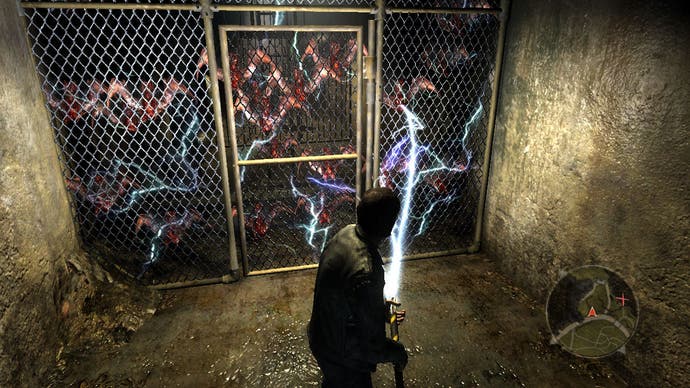Alone in the Dark
I think we're alone now.
Besides, you won't get much time to snort to yourself about the clichéd nature of amnesiac heroes. The game immediately pitches you into a scramble to escape the building as it collapses around you in fits and starts, torn apart from the inside by the fleshy, living cracks that you saw at the outset. Along the way, you'll learn how Carnby's various abilities work - this being, essentially, the most outrageously dramatic and narrative-heavy tutorial level we've ever seen.
From very early on, it's clear that the game's interactions are built primarily around its physics engine - more so, even, than those in Half-Life 2. Any object you pick up (and most objects can be picked up, shoved or pulled around) can be moved around with the right stick. Move it gently, and you'll simply hold it in that direction - perfect for lighting the end of a wooden chair in a fire in order to create an impromptu torch, or for using a length of piping to fish an electric wire from a puddle of water, for instance.
Move it more violently, though, and it becomes a weapon. Flick from side to side, and Carnby will slam the object sideways. Backwards and forwards, and he lifts it up and brings it crashing down in front of him. For now, you won't be using that much - Alone in the Dark doesn't introduce you to combat until surprisingly far into the first chapter, preferring to build up the tension by giving you ominous glimpses of the hideously scarred "possessed" humans you'll be fighting. Instead, you'll be using the same movements to navigate your environment.
In Carnby's hands, for instance, a fire extinguisher doesn't just get rid of flames (although it does that very effectively, and you'll be using these quite a bit). It can also be swung like a battering ram to smash wooden doors (or even to bend metal doors until they pop out of their frames), something the game shows you early on as you try to rescue a man trapped in a burning room with a jammed door. As you proceed through the floors, the building continues to disintegrate - with entire floors coming crashing down, forcing you to smash your way through, or rappel down sheer drops on lengths of electrical cable.

As it might sound, the whole thing is tightly scripted, and it's undeniably linear. We can easily forgive it that, however, because the whole thing is so astonishingly cinematic. The team seems to have perfected the art of using cut-away camera angles and occasional slow motion with excellent judgement, highlighting cool or high-tension moments without making the player feel that control is constantly being wrested from them.
By the time you escape the building, two other key elements of the game will have manifested themselves - combat and driving. Although you do have a gun (accessed through the excellent and intuitive inventory system, which just sees Carnby opening his coat and looking in the various pockets), it's actually more useful for solving puzzles and setting off explosions than for directly shooting creatures. Instead, you'll want to find the sturdiest item in the area (we rather liked fire axes, but those bottom-weighted poles used for holding up velvet ropes did nicely too) and swing it viciously at your foe.








